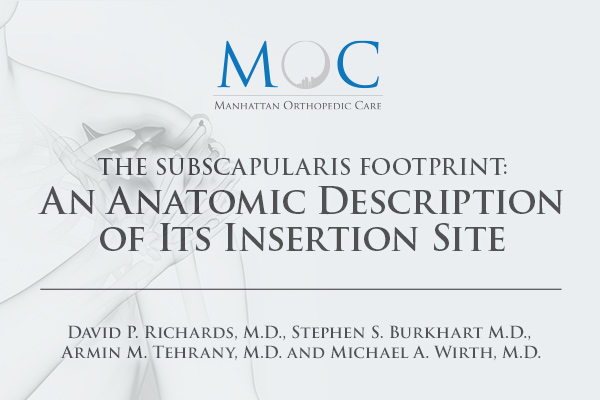In order to provide an extensive knowledge base for his younger colleagues and the generations to come, Dr. Armin Tehrany, M.D. teamed up with a group of outstanding orthopedic doctors and delivered a significant research study.
The Subscapularis Footprint: An Anatomic Description of Its Insertion Site article was published in Arthroscopy: The Journal of Arthroscopic & Related Surgery.
The journal is the leading source for comprehensive knowledge and information about emerging arthroscopic techniques and methods. All articles are peer-reviewed and they detail every important aspect for various arthroscopic surgeries. One of the most beneficial aspects of these articles is that the methods used for arthroscopic surgeries are discussed in relation to their efficiency, efficacy and cost benefit.

For this article, Dr. Tehrany had the pleasure to work with David P. Richards, M.D., Stephen S. Burkhart M.D., and Michael A. Wirth, M.D.
The purpose of the article is to describe the anatomic footprint of the subscapularis tendon. It was published in March 2007 Volume 23, Issue 3, Pages 251–254.
Following is the abstract of the article.
Abstract:
Methods: We examined 19 cadaveric shoulder specimens in this study. Dissection was carried out to the level of the subscapularis through a deltopectoral approach. The subscapularis tendon was identified, and the dissection was continued, elevating the tendon, subperiosteally, from its insertion site at the lesser tuberosity. The dimensions of the footprint were measured superior to inferior, as well as medial to lateral, by a single observer.
Results: The insertion of the subscapularis tendon on the lesser tuberosity was trapezoidal in shape. The mean length of the subscapularis tendon footprint was 2.5 cm (range, 1.5 to 3.0 cm). The superior portion of the footprint was the widest part of the subscapularis insertion. The mean width at the most superior aspect of the insertion site was 1.8 cm (range, 1.5 to 2.6 cm). The most inferior aspect of the footprint was much narrower, with a mean width of 0.3 cm (range, 0.1 to 0.7 cm).
Conclusions: The subscapularis insertion footprint has a broad and wide superior attachment that narrows distally to form a trapezoidal shape. We found the mean length of the footprint to be 2.5 cm. The mean superior width of the footprint was 1.8 cm, which was maintained for the upper 60% of the tendon insertion, at which point the footprint began to rapidly narrow to a minimum width of 0.3 cm at its most inferior aspect. The upper 60% of the footprint provided by far the major surface area for tendon insertion, consistent with prior findings of superior load transmission at the superior aspect of the footprint.
Clinical Relevance: This broad attachment site superiorly is likely important in load transmission. Knowledge of the shape of the footprint of the subscapularis, with a broad superior attachment, makes it easier for the surgeon to perform an accurate anatomic surgical reconstruction of the torn subscapularis.
The complete article is available for download here.

































